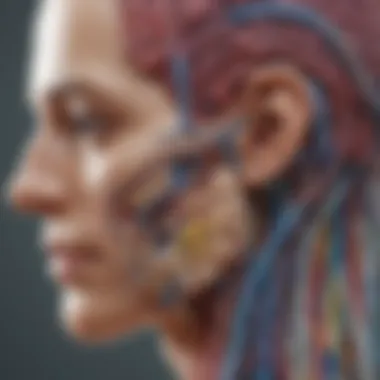Exploring the Brain's Hearing Centre: Structure and Function


Intro
The auditory processing center of the brain is critical for our experience of sound. Understanding its structure, function, and the way it interacts with our sensory perceptions allows for deeper insights into both normal and abnormal auditory processing. This section sets the stage for a comprehensive exploration of how the brain interprets auditory stimuli and how these processes can vary among individuals.
Key Research Findings
Overview of Recent Discoveries
Recent studies have advanced our understanding of the auditory cortex's role in sound processing. Neuroimaging technologies, like functional magnetic resonance imaging (fMRI), reveal how different areas of the auditory cortex respond to distinct aspects of sound. Much research highlights the plasticity of these neural networks, indicating how experience influences auditory perception. For example, proficient musicians show different activation patterns when processing rhythm and pitch compared to non-musicians.
- Auditory Hierarchy: The auditory system is organized in a hierarchical manner from primary auditory cortex to higher-order areas involved in complex processing.
- Tonotopic Organization: Regions of the auditory cortex are responsive to different frequencies, establishing a tonotopic map that ensures efficient sound processing.
- Neural Pathways: The brain employs various pathways to integrate auditory information with other sensory modalities, enhancing our perception of the environment.
Significance of Findings in the Field
The discoveries outlined are significant not only in understanding typical auditory processing but also in elucidating the mechanisms behind auditory processing disorders. For instance, findings related to how the brain adapts to hearing loss have crucial implications for developing effective auditory rehabilitation strategies.
"Understanding the intricacy of the neural pathways involved in hearing is vital for addressing auditory processing disorders."
Breakdown of Complex Concepts
Simplification of Advanced Theories
To grasp the anatomy and function of the auditory processing center fully, one must engage with some advanced theories. The Cochlear Nucleus, a crucial part of the auditory pathway, processes sound before it reaches the brain. This processing involves both temporal and spectral aspects of sound. Each component is integral to the overall auditory experience, often described as an intricate dance of neural activity.
Visual Aids and Infographics
Using visual aids can greatly facilitate understanding of these concepts. Diagrams illustrating the anatomy of the auditory pathways, such as the progression from the cochlea to the auditory cortex, can provide clear insights into the different stages of auditory processing.
Preface to Auditory Processing
Understanding auditory processing is essential for grasping how the brain interprets sound. This section emphasizes the significance of sound in our lives and how our auditory system works. The intricate processes involved in hearing not only impact communication but also influence emotional well-being and social interactions.
The Importance of Understanding Sound
Sound plays a crucial role in our daily experiences. It informs our actions, creates connections between individuals, and enhances our perception of the environment. Furthermore, comprehending how we process sound is vital for various fields such as education, psychology, and neuroscience. Sound perception affects learning, memory, and emotional responses, making it a critical area of study for improving human interactions.
The exploration of auditory processing unveils how sound waves are transformed into meaningful information. This understanding also highlights the implications of auditory processing disorders. When these systems fail, individuals may struggle with communication and social engagement, impacting their quality of life.
Overview of the Hearing Process
The hearing process is a complex sequence of events that begins when sound waves enter the ear. These waves travel through the outer ear, causing vibrations in the eardrum and transferring them to the tiny bones in the middle ear. Once the sound waves reach the cochlea in the inner ear, they convert into electrical signals. These signals then travel through the auditory nerve to the brain, specifically to the auditory cortex.
In summary, the hearing process entails:
- Reception: Sound waves are collected by the outer ear.
- Transduction: Vibrations are converted to electrical signals in the cochlea.
- Transmission: Signals travel along the auditory nerve to the brain.
- Interpretation: The brain analyzes these signals, allowing us to understand sound.
This overview sets the stage for a deeper investigation into the anatomy and functionality of the hearing center in the brain.
Anatomy of the Hearing Centre
Understanding the anatomy of the hearing centre is crucial for appreciating how we interpret sound. This section examines the precise location and key structures within the auditory processing centre of the brain. A clear grasp of these elements aids in comprehending not just how we hear, but also how sound is processed and understood. Disturbances in this system can lead to significant auditory processing disorders, making this knowledge essential.


Location within the Brain
The hearing centre is primarily located in the temporal lobe, specifically in an area known as the auditory cortex. This region is positioned near the lateral fissure, allowing its direct connection to structures involved in sound perception. It is essential for decoding sounds and facilitating auditory memory. The temporal lobe also houses other areas that contribute to modulating emotional responses to sounds. Recognizing the location of the auditory cortex helps us understand its role in auditory processing as well as its interaction with surrounding brain structures.
Key Structures Involved
The auditory processing centre comprises several key structures, each with unique functions that support hearing.
Auditory Cortex
The auditory cortex plays a vital role in interpreting sounds with precision. It processes frequency, pitch, and rhythm, contributing to our ability to recognize speech and music.
Its location in the temporal lobe allows efficient interaction with other sensory areas of the brain. The auditory cortex is characterized by its layered architecture, enabling complex processing of sound stimuli. A unique feature of this cortex is its ability to adapt to experiences, which means it can reorganize itself in response to auditory training or damage. This plasticity is significant when considering rehabilitation for hearing impairments.
Thalamus
The thalamus acts as a relay station for sensory information, including auditory signals. It filters messages and directs them to appropriate areas of the brain for further processing. A key characteristic of the thalamus is its role in integrating sensory modalities. This makes it a beneficial topic for understanding the broader context of auditory processing. The unique feature of the thalamus lies in its ability to prioritize signals based on attention. This can significantly enhance how we perceive sounds in noisy environments.
Cochlea
The cochlea is a spiral-shaped structure in the inner ear and it is crucial for converting sound waves into neural impulses. It is filled with fluid and contains hair cells that transduce sound vibrations. The cochlea’s tonotopic organization allows it to separate different frequencies of sound effectively. This organization is valuable in identifying distinct pitches. However, it is also important to note that damage to the cochlea can lead to hearing loss, as it directly affects its ability to convert sound waves efficiently.
Neural Pathways and Auditory Processing
The significance of understanding neural pathways and auditory processing cannot be overstated. This area encompasses the intricate routes through which sound signals travel and how these signals are interpreted within the brain. Recognizing these pathways allows for deeper insight into auditory functioning and disorders. The comprehension of these pathways aids researchers and clinicians in identifying potential disruptions in typical auditory processing, which can lead to developmental or acquired hearing challenges.
Sound Signal Transmission
Sound signal transmission involves a complex sequence of events. When sound waves enter the ear, they undergo a series of transformations before reaching the auditory cortex in the brain.
- Entry and Amplification: Sound waves travel through the external ear to the eardrum, causing it to vibrate. These vibrations are then transmitted through the middle ear's ossicles, amplifying the sound.
- Cochlear Processing: The vibrations are ultimately transferred to the cochlea, where the movement of fluid within this structure stimulates hair cells. These hair cells convert mechanical energy into electrical signals.
- Transmission to the Brain: The auditory nerve carries these electrical signals to various brain regions, including the thalamus and auditory cortex, for further processing and interpretation.
Understanding this process helps unveil how even minor disruptions can affect one’s ability to hear and process sound accurately. It sheds light on how sound is not just heard but also interpreted, thus influencing communication and interaction with the environment.
Role of the Brainstem
The brainstem plays a crucial part in auditory processing. It serves as a relay station for sound signals traveling from the cochlea to higher brain centers. Within the brainstem, there are several nuclei that are specifically designed for auditory processing, such as the superior olivary complex and the inferior colliculus.
- Integration of Sound Information: The brainstem integrates sound information, distinguishing between what is essential and what is not. It helps in localizing sound direction and timing, vital for understanding speech in noisy environments.
- Reflexive Responses: The brainstem is also responsible for reflexive responses to auditory stimuli, such as the startle reflex. This is critical for survival, as it enables quick reactions to unexpected sounds.
Physiological Mechanisms of Hearing
Understanding the physiological mechanisms of hearing is crucial to grasp how auditory processing occurs in the human brain. This section will explore the processes involved in sound wave reception and the subsequent neural encoding of sound. By delving into these mechanisms, we can better understand how our brain interprets auditory signals, leading to perception and recognition of sound.
Sound Wave Reception
Sound wave reception is the first step in auditory processing. When sound waves travel through air, they vary in amplitude and frequency. Humans can perceive these variations, allowing us to detect different sounds. The structure of the ear plays a key role in this process.
The outer ear collects sound waves and funnels them through the ear canal to the eardrum. As sound waves vibrate the eardrum, these vibrations are transferred to the ossicles, a set of small bones in the middle ear. The ossicles amplify these sounds before they reach the cochlea in the inner ear. At this point, the sound waves are converted into fluid vibrations.
Inside the cochlea, hair cells line the interior. These cells are essential for capturing sound waves. When fluid vibrations move through the cochlear structure, they cause the hair cells to bend. This bending creates electrical impulses, which are sent to the auditory nerve. These complex interactions enable the initial processing of sound, which is fundamental to hearing.
Neural Encoding of Sound


Once sound waves have been received and transformed into electrical impulses, the brain begins the complex process of neural encoding. This step is vital as it dictates how sound is interpreted and understood.
The auditory nerve carries the electrical signals from the cochlea to the auditory cortex, located in the temporal lobe of the brain. Here, the cortex decodes various aspects of sound, such as pitch and loudness. This decoding is facilitated by different populations of neurons that respond selectively to certain frequencies. It is important to recognize that the coding of sound is not a simple one-to-one mapping; instead, it involves a more complex pattern of excitation and inhibition across auditory pathways.
Moreover, the brain also engages in processes of integration and interpretation. Sounds are not merely recognized by their frequency or intensity. The brain analyzes patterns in auditory input and compares them to stored memories and experiences, enabling us to recognize familiar sounds, such as a friend’s voice or music.
Insightful neural network models are increasingly being used to simulate and understand how the brain encodes sound. The implications of these models are significant for advancing research in auditory processing.
Employing a variety of techniques, such as functional MRI, researchers are consistently making strides in revealing how the auditory system encodes sound. This ongoing exploration is vital for identifying dysfunctions related to auditory processing disorders.
In summary, the physiological mechanisms of hearing encompass both the intricate processes of sound wave reception and the complex neural encoding that follows. Gaining insights into these processes provides essential information that can inform treatment approaches and improve our understanding of auditory perception.
Variability in Auditory Perception
The study of variability in auditory perception is significant within the broader research of the hearing centre. Understanding how different individuals perceive sound can aid in many fields, including audiology, education, and neuroscience. Variability is influenced by several factors that shape personal auditory experiences.
Factors Affecting Hearing
Age
Age plays a crucial role in how sound is perceived. As people age, they often experience changes in their hearing ability. This aspect contributes greatly to discussions of auditory perception. Older individuals may face presbycusis, a form of age-related hearing loss that often makes it harder to hear high-frequency sounds.
One key characteristic of age is that auditory processing may slow down, affecting how quickly someone can react to sounds. This makes the exploration of age-related changes highly relevant in this article. While aging can lead to a decrease in hearing quality, it also opens avenues for research on adaptive strategies that older adults use to cope with these challenges. Thus, reviewing age-related factors leads to greater understanding and potentially improved auditory health methods.
Health Conditions
Health conditions also significantly impact hearing. Various illnesses and conditions can lead to auditory processing variations. One key characteristic is that some health issues can deteriorate auditory capabilities. For instance, conditions such as tinnitus or otosclerosis manifest uniquely, causing noticeable variations in sound perception. This specificity makes discussions of health conditions quite relevant in this article.
Health conditions might influence how individuals experience sound and make it essential to consider these factors in auditory research. Understanding the relationship between different health conditions and auditory perception is necessary to tailor interventions effectively.
Environmental Influences
Environmental influences are critical in shaping how sounds are perceived. Noise pollution, for instance, affects auditory processing in individuals exposed to high levels of ambient noise. This feature is worth noting as these environmental factors may lead to desensitization or reactivity changes over time.
The specific impact of environmental influences is particularly important for this article, as it highlights the external factors that can modify auditory experiences and perception. People in quieter environments may develop sharper sound discrimination skills compared to those constantly exposed to noise. Understanding these influences assists researchers in creating strategies to enhance auditory functioning based on individuals' specific environments.
Differences in Processing Sound
Variability also arises from individual differences in processing sound. These differences can stem from genetic factors, personal experiences with sound, or neurological variations. Research indicates that some individuals might excel in discerning pitch or rhythm, while others may find these tasks increasingly challenging. Such disparities underscore the need for tailored approaches when addressing auditory processing, particularly in educational and therapeutic settings.
"Understanding variability in auditory perception is crucial for effective intervention and support in individuals experiencing hearing challenges."
Overall, investigating variability in auditory perception provides insight into the intricate workings of the hearing centre. Knowledge of these factors enhances our understanding and helps create more personalized approaches in hearing research and therapy.
Auditory Processing Disorders
Auditory Processing Disorders (APD) represent a significant area of concern in understanding auditory function. They affect how the brain processes sound information. Recognizing APD is essential, as it can impact language development, learning, and social interactions. Understanding APD helps in developing effective strategies for teaching and support, making this topic vital for educators and healthcare professionals.
Understanding Auditory Processing Disorder
Auditory Processing Disorder refers to difficulties in the processing of auditory information in the brain. Individuals may hear sounds, but their ability to interpret what they are hearing becomes compromised. This can result from various factors, including neurological changes, environmental conditions, and even genetic predispositions. APD does not imply a hearing loss, but rather a disconnect between hearing and comprehension.
Symptoms and Diagnosis


Symptoms of APD can manifest in various ways, often leading to misunderstandings or misinterpretations of verbal information. Common symptoms include:
- Difficulty following spoken instructions
- Trouble distinguishing similar sounding words
- Increased difficulty in noisy environments
Diagnosis typically involves comprehensive evaluations by audiologists or speech-language pathologists. They may use a series of auditory tests to measure how well an individual can process sounds. It is crucial to identify APD early, as intervention strategies can aid in improving communication skills and overall functioning.
Impact on Daily Life
The impact of Auditory Processing Disorders can be profound. Individuals may struggle in academic settings, facing challenges in understanding lessons or participating in discussions. Social interactions can also suffer, as misunderstandings can lead to frustration and isolation. The daily life of someone with APD may involve:
- Frequent requests for repetition due to misunderstandings
- Avoidance of group activities or conversations
- Low self-esteem stemming from communication challenges
Addressing these impacts requires a multi-faceted approach, including therapy, environmental adjustments, and support systems. Ultimately, awareness and understanding of APD can help improve the quality of life for those affected.
Recent Research in Auditory Function
Recent studies in the field of auditory function have proven crucial for advancing our understanding of how the brain processes sound. The relationship between auditory processing and various facets of cognitive function is becoming more evident as scientific inquiry deepens. This section highlights certain elements, benefits, and considerations that stem from recent research in auditory function.
One notable aspect of current research is the exploration of how auditory experiences influence neural plasticity. This refers to the brain's ability to adapt and reorganize itself based on new experiences. These findings are significant in developing rehabilitation strategies for individuals with hearing impairments or auditory processing disorders. Enhanced methodologies in auditory training could lead to improved outcomes in recognizing speech and other sounds.
"Auditory training can effectively reshape how the brain responds to sound, thus facilitating better auditory perception."
Through rigorous exploration of auditory function, researchers examine the links between sound processing and other cognitive processes such as memory, attention, and language skills. Understanding these interdependencies can yield insights into practical applications in educational settings. Incorporating auditory training programs in curricula may help students with learning difficulties.
Furthermore, recent advancements in technology have led to novel neuroimaging techniques, which significantly enhance the study of auditory function. These tools provide a clearer picture of the auditory pathways and regions activated during sound processing, allowing for a more detailed analysis of individual variability. This understanding can help differentiate between typical and atypical auditory processing, which is vital for targeted interventions.
In essence, recent research in auditory function not only broadens the scope of academic inquiry but also aids in developing more effective clinical practices. The integration of neuroscience findings into educational and therapeutic settings is a promising avenue for future innovations. By continuing to explore these areas, we gain deeper insights that may lead to improved strategies for addressing auditory processing disorder and advancing broader neurological understanding.
Advancements in Neuroimaging Techniques
The evolution of neuroimaging techniques has paved new pathways for understanding auditory processing in the human brain. Technologies such as functional magnetic resonance imaging (fMRI) and magnetoencephalography (MEG) enable researchers to observe brain activity in real-time as subjects respond to auditory stimuli. These methods provide invaluable data about which regions of the brain are activated during specific auditory tasks.
The precision of neuroimaging allows for detailed analysis of the auditory cortex and its connections with other brain regions. This has facilitated a deeper comprehension of how sound perception varies between individuals, shaping our understanding of cognitive diversity. Importantly, advancements in these imaging techniques lead to more personalized approaches in identifying and treating auditory processing disorders.
In summary, the strides made in neuroimaging are instrumental for enhancing our grasp of auditory function, providing a robust foundation for future research initiatives.
Insights from Neuroscience Studies
Recent neuroscience studies highlight the intricate workings of the auditory system and its connectivity to various cognitive functions. One crucial insight is that auditory processing is not isolated; it interfaces with visual and sensory integration mechanisms within the brain. This rich interplay can influence how we perceive and interpret sounds in our environment.
Research indicates that individuals with heightened auditory sensitivity often exhibit notable differences in neurological structure and function. Identifying these differences is pivotal for understanding the broader implications of auditory processing in individuals with unique perceptual experiences. Such distinctions may inform strategies for supporting those who face challenges related to sound processing.
Moreover, ongoing studies are revealing the role of attention in auditory processing. Findings suggest that an individual's focus can significantly alter sound perception. This realization has potential applications in optimizing learning environments and therapeutic settings, ensuring that auditory information is best received and understood.
Epilogue
Summary of Key Points
- The auditory processing center allows for the intricate interpretation of sound signals.
- The anatomy of the hearing centre includes vital structures such as the auditory cortex, thalamus, and cochlea, which play distinct roles in sound processing.
- Factors like age, health conditions, and environmental aspects can significantly affect individual auditory perception.
- Auditory processing disorders impact daily life, revealing a need for better diagnosis and management strategies.
- Recent research emphasizes advancements in neuroimaging techniques, aiding our understanding of auditory processing.
This summary encapsulates the key components discussed, affirming the complexity and significance of the hearing centre within human cognition and experience.
Future Directions in Research
Continuing research is paramount to enhance our understanding of auditory processing. Future inquiries may include:
- Investigating the neural plasticity of the auditory system in response to rehabilitation strategies.
- Studying the impact of modern urban environments on auditory processing capabilities.
- Exploring the genetic and molecular factors that contribute to auditory processing disorders.
- Developing advanced neuroimaging tools to visualize auditory pathways in real time.
By focusing on these areas, researchers can work towards comprehensive approaches that improve auditory health and contribute to effective interventions for those with auditory processing limitations. The exploration of the hearing centre's role will lead to a deeper understanding of both auditory and broader neurological functions.















